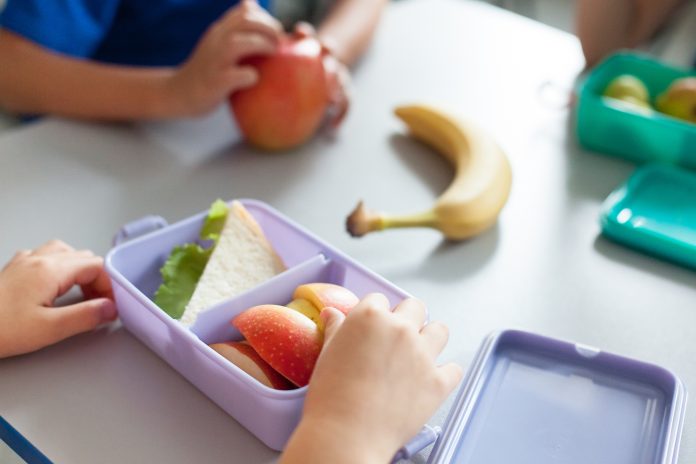A new 2024 study has revealed that young British children are eating a diet that consists largely of ultra-processed food (UPF)
Published in the European Journal of Nutrition, the study analysed food diaries from over 3000 children and concluded that UPF makes up 46.9% of the diet of children aged up to 21 months and 59.4% of those aged 7 years.
This is worrying because of the harmful effects of UPF, and the fact that consuming UPF in toddlerhood, leads to an increase in UPF consumption by age 7. This trend towards UPF will likely continue to increase into adult life, with many negative consequences for health in adult life.
- What is UPF?
- Why is UPF dangerous for children’s health?
- How to make changes to a child’s diet to minimise their intake of UPF?
What is UPF?
UPF is food that has been modified in some way to make it more palatable or to improve its shelf life or storage capacity. A UPF is any type of food that contains ingredients you could not easily find in a home. As a rule of thumb, if a food label lists 5 or more ingredients, this is likely to be a processed food.
Manufacturers make UPF look appealing and taste good to sell their products. Most UPFs are high-fat, high-sugar, high-salt, and high-calorie. They often contain additives such as colourants, thickening agents, emulsifiers and preservatives. UPFs tend to be lower in protein, vitamins and fibre than whole foods. They are often cheaper to buy, have a longer shelf life and are quick and convenient – all very attractive in the current cost of living crisis and when juggling a busy household.
Why is UPF dangerous for children’s health?
Children are growing and developing and their diet is crucial for them, to achieve their potential. Establishing healthy eating in childhood is vital as this affects eating habits in adult life. There are many evidence-based reasons why eating too much UPF is dangerous for children’s health.
- A diet high in UPF is high calorie but deficient in micronutrients – vitamins and minerals.
- Children eating large amounts of UPF tend to be shorter and heavier. UPF consumption is linked to stunted growth and childhood obesity. 55% of obese children will still be obese in their teenage years. 80% of these will go on to be obese adults. Obesity is a major risk factor for cardiovascular disease in adults and is linked to raised cholesterol, high blood pressure and type-2 diabetes.
- UPF is associated with behavioural problems and in particular, attention deficit hyperactivity disorder (ADHD).
- A high UPF consumption significantly increases the risk of dental caries (tooth decay) in children of all ages but specifically in those under 6 years old.
- Some experts believe UPF is addictive – in a similar way to nicotine or alcohol addiction. High-fat, high-sugar foods have been shown to cause an immediate release of dopamine in the brain, in just the same way as a shot of nicotine or alcohol. Feeding children UPF is encouraging them to develop UPF food addiction at a young age.
How to make changes to a child’s diet to minimise their intake of UPF?
Your child needs a healthy balanced diet that contains plenty of protein and is packed with nutrients from wholegrains, fruit and vegetables. Start by planning their meals with this in mind.
Protein – Choose lean protein such as lean red meat, chicken, fish, seafood, soybean products, other beans and other legumes, unsalted nuts and seeds.
Avoid saturated animal fat – Remember that fast foods such as pizza, burgers and hot dogs are high in animal fat and should be avoided. You can make your own healthy alternatives at home instead.
Add veggies – Add colourful veggies to dishes and cook from scratch at home. These can be fresh, frozen or canned (avoid cans with salted water). Cut the veg up small and add them to soup, stews and casseroles. Get them to eat what you eat. You need to eat your veggies too!
Increase the fibre – Fibre in the diet is essential to add digestion and avoid constipation. Avoid white bread, rice or pasta which has little fibre. Go for brown (wholegrain) bread, rice and pasta. Other foods high in fibre include porridge oats, bran flakes and whole wheat bisk. Avoid high-sugar breakfast cereals.
Dairy products – Dairy products are an excellent source of protein and calcium for young children. Over the age of 1 year, it’s quite safe for children to have semi-skimmed or skimmed milk products. You can also use low-fat milk in cooking to avoid the child having unnecessary quantities of saturated fat. Don’t pick flavoured yoghurts with added sugar – go for plain yoghurt, preferably with live cultures (probiotics) and add your own fruit as a flavouring.
Avoid hidden fats – Keep in mind that unhealthy, saturated fats are hidden in food such as biscuits, desserts, ice cream and cake. You can make low-fat and healthy alternatives using recipes that utilize healthy oils such as rapeseed oil, and honey instead of sugar, oatmeal, apple and nuts. Cooking with children is fun and they often love to eat what they’ve cooked.
Check the food labels – Children should not have high-salt food. Salt may be hidden and is present in large amounts in crisps, pizza, pasta sauces, bread, ready meals and sausages. Look for low salt options – or no added salt. The product label for salt should be green.
Snacks -If your child needs a snack, ensure it is healthy as possible. The NHS has a great suggestion list that includes, for example, homemade popcorn, muffins with cream cheese, and pitta breads with a tuna dip. Fresh fruit is a great option—natural sugars in fruit are not dangerous like added sugars.
No fizzy drinks, fruit juice or squash – It’s very important not to allow children to drink fizzy drinks which are packed full of sugar and additives. They can be given sparkling water instead. Children should not drink fruit juice, fruit squash (not even the low-sugar variety) or energy drinks. It’s ideal to put tap water on the table every mealtime and encourage them to drink at least one glass with every meal.
Only occasional treats – Children aged under two should not be given any sugar, so they should not have chocolate or sweets. After this age, they should only have chocolate or sweets for an occasional treat or a special occasion. Parenting is very hard, but it’s an easy option to settle a tantrum with a treat. But why not try to reward them for good behaviour with a nonfood item such as a sticker or a trip to the park, instead?
Make food and mealtimes fun – From the start, get children interested in food. Ask them to help you with simple preparation and laying the table. Make sure you eat as a family and mealtimes are happy family times. You eat what they eat. They will learn and adapt from this, including their practical skills using a knife and fork, and their speech development.
Plan your meals and shop with a list – Always plan your meals and make a shopping list. Stick to the list. Batch cooking works out best. This will help ensure you are creating healthy meals, minimising waste and keeping within your budget.
Final thoughts
Feeding our children is fundamental for their future health and development. Despite all our best efforts we’ve been doing it wrong for so long! Now the data is here, and we know we are leading our children to an unhealthy adulthood, we have an opportunity to do something about it. I was surprised to read that only 1.6% of lunchboxes are as nutritious as a school lunch!
If you are a concerned parent reading this, I’m sure you can see there’s so much we can do to improve our children’s nutrition and help their growth, health and future development.
- What could you do today to make sure your child eats less UPF?
- What simple measures could you take?
For more information
-
- The Association of UK Dietitians – Healthy eating for children











